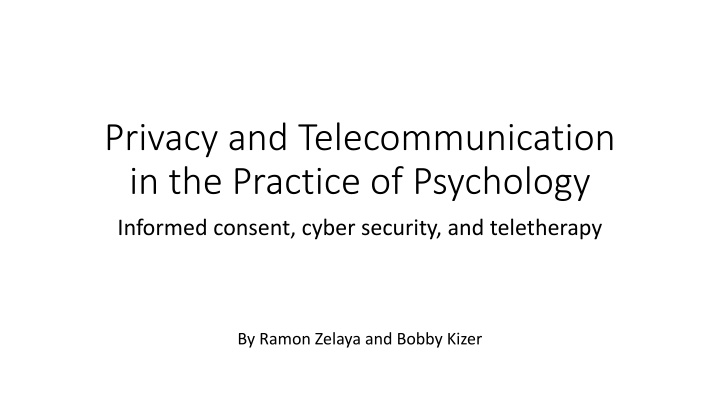
Ensuring Privacy and Cybersecurity in Teletherapy Practice
Discover best practices to safeguard patient privacy and uphold cybersecurity in teletherapy sessions. Learn about informed consent, HIPAA compliance, and secure communication methods. Find out considerations for protecting sensitive information and explore software options to enhance data security.
Uploaded on | 0 Views
Download Presentation

Please find below an Image/Link to download the presentation.
The content on the website is provided AS IS for your information and personal use only. It may not be sold, licensed, or shared on other websites without obtaining consent from the author. If you encounter any issues during the download, it is possible that the publisher has removed the file from their server.
You are allowed to download the files provided on this website for personal or commercial use, subject to the condition that they are used lawfully. All files are the property of their respective owners.
The content on the website is provided AS IS for your information and personal use only. It may not be sold, licensed, or shared on other websites without obtaining consent from the author.
E N D
Presentation Transcript
Privacy and Telecommunication in the Practice of Psychology Informed consent, cyber security, and teletherapy By Ramon Zelaya and Bobby Kizer
Best practices and how to accomplish this Last meeting we discussed ethical ways to use teletherapy. This brought up many concerns about privacy and technology. Some themes include: Use HIPAA compliant forms of communication Keep patient s privacy a priority Inform the patient about possible risks to their privacy when using electronic forms of communication (Informed Consent) Have a complete electronic back-up. If cloud-based, use an encrypted form of storage Be sure of jurisdictional rules
Examples of some ways to help protect privacy Phone: use a password or fingerprint, delete text messages regularly (after charting them), do not save patient information on your phone s address book. Email: use a third party secure email service, delete email messages regularly, change passwords regularly, do not send identifying information over email, send Protected Health Information (PHI) via encrypted means. Other software: If there is any chance somebody could get to your computer, password protect all private information. Microsoft can now do this very easily, though there are other ways as well. More on these later
Considerations the patient should be aware of It is important that the patient understand the risks involved with telecommunication: Security measures can be followed, but security cannot be guaranteed Devices left open, unlocked, or unattended can be viewed by others Devices may be lost or stolen Malware, hacks, viruses, and other malicious security breaches User error (wrong number, mistyped address) Deleting a message doesn t mean it s erased from existence!
Examples of informed consent documents See handouts...
All-in-1 apps/software There are many providers that offer a platform for scheduling, electronic records, billing, insurance filing, credit card processing, sometimes teletherapy, etc. These will require a fee, and somewhat of a learning curve (though pretty user friendly). Here are a few www.therapyappointment.com ($57.50/mo) www.theranest.com ($1/mo per client) Why might you use such a program: convenience, ease of access for you and patient, lower overhead than office assistant, secure Office therapy/docutrac http://www.docutracinc.com/products-pricing/
Local Password Protection Use a strong password on your operating system Password protect back-ups and any sensitive folders Note that windows does not have an option for password protecting entire folders, you would need 3rdparty software for that Encrypt and password protect specific documents Easy to do in Office (show how to do this in Office) File Save/Saves as tools General options password to open/modify Or File Export create pdf options Encrpyt the document with a password
Cloud Storage There is no requirement to have cloud storage, you can simply back- up all of your data on an external drive (password protected) and store in a separate location. But nowadays, cloud storage is easy to come by, and can t be burned down, lost, or stolen. Store documents in the Cloud and protect in HIPAA compliant ways Office 365 is not HIPAA compliant with a BAA Microsoft exchange for email can be HIPAA compliant Other cloud storage options SpiderOak Wuala Drop-box might have a HIPAA compliant paid option
Sending Encrypting Documents Encrypt the document with Office ahead of time. Export-> add encryption and password (super easy, and free if you have Office) https://www.howtogeek.com/124824/how-to-password-protect-pdf-files-in- word-2013/ Kryptel Silver Key (encrypts and password protects attachments) http://www.kryptel.com/download/ free Virtru (encrypts and requires recipients to verify their identity) https://www.virtru.com/ free Adobe Encrypt .pdf using adobe SC, very easy, but cost $12/mo
Teletherapy Teletherapy was covered in the last presentation, but the bottom line is that teletherapy is allowed, but requires a few specific things: comply with licensure rules in the state they are located (most states require at least a temporary licensure : http://www.apapracticecentral.org/advocacy/state/telehealth-slides.pdf Notes should include the location of the patient and that the session was conducted via teleconference have emergency contact information on file for the patient s current location, Comply with any other state specific rules for teletherapy, for example, in Louisiana, teletherapy must include video AND audio Bill accurately: for insurance purposes, you can use the same therapy codes, but add the correct location (usually 12 for in-home) and the specifier code GT. Reimbursement rates are typically the same as in person. From experience, I taked BCBS-PPO, and the reimbursements rates for 90837 GT and 90834 GT are exactly the same.
Teletherapy software Determine HIPAA compliance. If you are not using a HIPAA compliant platform, be sure to inform the patient of the potential risk, even if minimal. Software designed for teletherapy/telemedicine. Example: Theraplatform- https://www.theraplatform.com/ Breakthrough.com Free and HIPAA compliant: VSEE and doxy.me The con is that this typically requires a little more work on the patient s end to become familiar with the specific software and setup an account Skype and Facetime-both offer encryption, but do not have a BAA (Business Associate Agreement) with HIPAA. Some say these services are an exception because they are only a conduit. The problem here is that there have apparently been cases when law enforcement has had access to calls. This implies that they have the encryption key and can decode it. https://www.linkedin.com/pulse/facetime-hipaa-compliant-jon-taylor http://www.zurinstitute.com/skype_telehealth.html
Are you scared of technology? Are you nervous about using email for communication? Or nervous about teletherapy? Or worried about using online scheduling and billing tools? Are you scared of how the internet is affecting the world and the way that we do business? Concerned about privacy and confidentiality. We are going to show you some ways to protect yourself, manage your liabilities, and use technology as an asset. For a non-clinical example
Are you scared of how youtube is affecting you and your loved ones? Good things can come from youtube This is not directly related to doing therapy, but I just wanted to share one example of a way that technology affects psychology practice. I m not saying we need to show these clips to our clients, but just know that they might across them, that even staring at a screen can be part of identity development. Many of the famous youtubers right now are actually in their mid 20s and seem to have a decent amount of self-awareness and lots of positive things to say about things like self-esteem and identity. Here s one example. Thomas Sander, a famous viner turned youtuber (2 million subscribers) https://www.youtube.com/watch?v=pFdg8l25D2k Thomas Sanders exploring Identity https://www.youtube.com/watch?v=S9xPOCk91mc&list=PLYA7DZ_sbUzvB1l6KsO5LZV2rrk2u1xl 4 Thomas Sanders exploring his Anxiety https://www.youtube.com/watch?v=rjMxXTCGPu8&index=3&list=PLYA7DZ_sbUzvB1l6KsO5LZV 2rrk2u1xl4






















